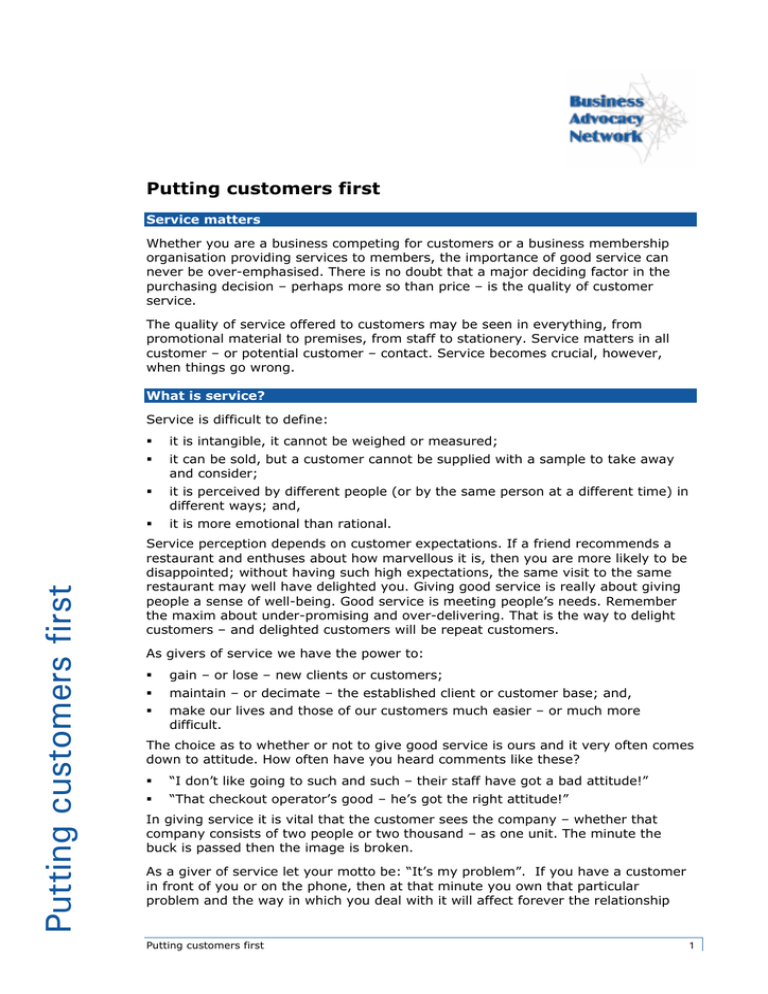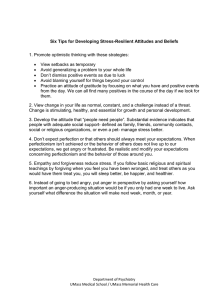Putting customers first - Business Advocacy Network
advertisement

Putting customers first Service matters Whether you are a business competing for customers or a business membership organisation providing services to members, the importance of good service can never be over-emphasised. There is no doubt that a major deciding factor in the purchasing decision – perhaps more so than price – is the quality of customer service. The quality of service offered to customers may be seen in everything, from promotional material to premises, from staff to stationery. Service matters in all customer – or potential customer – contact. Service becomes crucial, however, when things go wrong. What is service? Putting customers first Service is difficult to define: it is intangible, it cannot be weighed or measured; it can be sold, but a customer cannot be supplied with a sample to take away and consider; it is perceived by different people (or by the same person at a different time) in different ways; and, it is more emotional than rational. Service perception depends on customer expectations. If a friend recommends a restaurant and enthuses about how marvellous it is, then you are more likely to be disappointed; without having such high expectations, the same visit to the same restaurant may well have delighted you. Giving good service is really about giving people a sense of well-being. Good service is meeting people’s needs. Remember the maxim about under-promising and over-delivering. That is the way to delight customers – and delighted customers will be repeat customers. As givers of service we have the power to: gain – or lose – new clients or customers; maintain – or decimate – the established client or customer base; and, make our lives and those of our customers much easier – or much more difficult. The choice as to whether or not to give good service is ours and it very often comes down to attitude. How often have you heard comments like these? “I don’t like going to such and such – their staff have got a bad attitude!” “That checkout operator’s good – he’s got the right attitude!” In giving service it is vital that the customer sees the company – whether that company consists of two people or two thousand – as one unit. The minute the buck is passed then the image is broken. As a giver of service let your motto be: “It’s my problem”. If you have a customer in front of you or on the phone, then at that minute you own that particular problem and the way in which you deal with it will affect forever the relationship Putting customers first 1 between your organisation and the customer. So smile, use your initiative and solve the problem. “Moments of truth” which are rewarding to a customer will normally ensure a purchase, good word of mouth publicity and future business. As service givers we should try to leave each customer with a feeling of well-being and a positive image of the company. Benefits of good service If, as service givers, we deal with our customers effectively and efficiently, the company will benefit in a number of areas: the cost of solving problems will be minimised; a relationship is developed between the company and the customer; the possibility of supplying additional products and services is opened up; and, it introduces the customer to an area of the company other than sales. Whilst causing problems for customers is not to be recommended, General Electric has found that customers who bought their products and subsequently had problems which were effectively resolved, were three times more likely to purchase further products and services than those customers who had not had any problems at all. Very often in customer service we only get the chance to show how good we are when something goes wrong, but what the customer remembers is the successful outcome of the transaction – hence their confidence in making further purchases. Who is your customer? Perhaps you think that the people who have direct contact with paying customers or clients are the only ones who need to consider service. You, as someone who deals purely with people inside the company, are not a giver of service and do not have customers yourself. Wrong! People with whom you deal inside the organisation are your customers – internal, rather than external customers – but still deserving of the same consideration and care. What your customer expects The customer wants: someone who will listen; someone who will solve their problem; and, someone who will do what they say they will. Or, to put it another way, the customer wants to speak to someone who is: Courteous Friendly Understanding Informal Sincere Responsive Tolerant Smiling Open-minded Truthful Motivated Empathetic Reliable Note the initial letters – they spell CUSTOMER FIRST! There are other factors you may have listed – accepting, non-judgemental, trustworthy, professional – and these are equally valid. Lists like this grow longer the more time you spend thinking about them. What you can’t do is put these points into an order of importance – that depends on your customer. Remember, too, that customers are neither aware 2 Business Advocacy Fund of nor interested in how many other customers there are or how busy you may be. As far as they are concerned, you have one customer and one problem with which to deal! Solving your customers’ problems Whether your customers contact you in person, by telephone or by letter, you can use the SERVICE method to solve their problems, remember that two-way communication is always more effective than one way. Everything is easier if taken one step at a time and resolving customer complaints is no exception. The method described here is a practical guide to covering all the bases which, with practice, can become second nature. Say hello Establish it’s for you Research the facts Verify the facts Initiate proposal Commit to action End transaction Dealing with difficult situations The people with whom you have to deal as a giver of service may behave in a number of ways. They may be confident and assertive, angry, upset, unsure... any one of a number of attitudes may surface during the transaction. Customers who begin by behaving in a “reasonable” manner and who then become “unreasonable” are reacting to the way with which they are being dealt. It could be that you are not matching their expectations - perhaps they feel you are not listening, or not asking enough questions, or that you don’t understand. Using the SERVICE method and following the procedure will generally avoid this sort of unpleasantness. Customers who are immediately unreasonable are in a highly emotional state. They can be hard to tie down on factual information, they have a need to express the frustration and anger which they feel and they are looking for recognition of their state of mind. When you are dealing with someone who is angry, it can be very tempting to apologise – even though at this stage you may not even know exactly what you are apologising for. You may also be tempted to shout back, or at the very least to let your displeasure show in your face or voice. Resist both of these temptations; although they are both perfectly natural – when faced with an aggressor it is human nature to either run away or fight back – neither response will do in a service situation. What you must do is rise above it and not take it personally – after all, it isn’t you with whom the customer is angry, it is the situation; you just happen to be a convenient target. You still have to deal with it, however; if you ignore the anger it is adding fuel to the flames. Instead, empathise with the customer. After all, it’s perfectly normal to get angry when things go wrong. You can use phrases like “I can understand you being angry – I’m sure I would be, too”. Don’t interrupt customers who are getting something off their chest; nod, say “I see”, “I understand”, give them your full attention and they will calm down. Once the anger has been dealt with, start getting the facts. Use simple, direct, open questions to focus the customer on the situation rather than the emotion. Use SERVICE to give your transaction a structure and nine times out of ten, the customer will apologise for shouting and thank you for your help. Putting customers first 3 Customer service strategy In order to be sure that we consistently put the customer first and provide high quality customer service, we need to formulate a strategy. Any customer service strategy must be: an integral part of the strategy for the business as a whole; put in writing; effectively communicated to all staff; and, effectively communicated to all existing and potential customers. It can be helpful to develop a simple and easily understood customer care mission statement. Apple Computer states that “Our goal has always been to create the world’s friendliest, most understandable computers – computers that empower the individual”. A customer service mission statement might be something like, “we will endeavour at all times to put the needs of the customer first, by selling products and services that don’t come back to customers who do”. Short mission statements are more likely to excite and inspire stakeholders and are more likely to be remembered by staff. The best way to find out what it is that customers want, what they like about you and what they don’t like, is to ask them. Make it as easy as possible for customers to tell you what they think, perhaps by having a suggestion box or conducting a customer survey. Have a mechanism for recording complaints from customers and actively seek this information – it is among the best business information you can get, and it is free. Having an established complaints policy and welcoming complaints from customers will pay off – after all, those that don’t bother to complain are already lost to you. Having discovered what your customers really think of you and formulated your mission statement, you must develop and agree standards of performance with all personnel to enable the customer care mission statement to be implemented. Everyone should be encouraged to have a personal stake in the company’s success – everyone owns the mission statement and should take a pride in achieving the specified aim. In return, people should be supported and developed by the company. Performance should regularly be assessed against performance standards and results recognised and rewarded. Performance standards will need to focus on customers and their interface with and experience of the organisation’s service delivery and, ideally, encompass a series of specific quality statements covering: Building customer relationships Maximising market awareness Developing people Conclusion “Customer first” is an attitude and one which must be held by every member of a company in order for it to become a reality. You will hear the attitude described in different ways but, however it is described, it means recognising the value and potential benefits of offering high quality customer service to all. Further information For further information on putting customers first, go to www.customerfirst.org 4 Business Advocacy Fund


